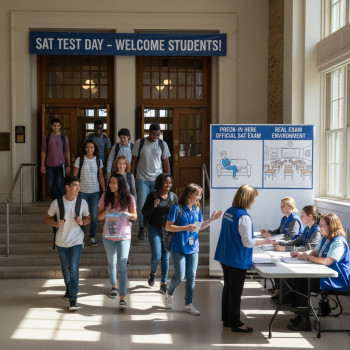Which Colleges Value SAT More Than GPA? The Short Answer (and Why It Matters)
If you ask ten admissions officers, you’ll get a dozen thoughtful variations on the theme: colleges consider the whole student. Yet in practice, some colleges and programs—especially selective ones—will look at a high SAT score as powerful, sometimes more persuasive than a shaky GPA. That doesn’t mean SAT trumping GPA across the board; it means the relative weight depends on context: test policies, the applicant’s transcript, school profile, and the program applied to.
This guide is for students and parents navigating the digital SAT era and top-college admissions. We’ll demystify which institutions are likelier to give extra weight to SAT scores, how to present your strengths, and practical strategies (including how Sparkl’s personalized tutoring can amplify your test-day performance) so you can make an informed plan.

Understanding the Landscape: Test-Optional, Test-Required, and Test-Preferred
First, let’s set the scene. In recent years many colleges shifted to test-optional policies. That means you can choose whether to submit SAT scores. But the policy label alone doesn’t map perfectly to how much a school actually uses scores.
- Test-Required: These colleges expect SAT/ACT scores for admission. If you want to apply, you must submit scores.
- Test-Optional: You can submit scores, but you don’t have to. Importantly, a strong SAT can still strengthen your application—especially if your GPA or school context doesn’t fully capture your potential.
- Test-Preferred / Test-Flexible: Some colleges ask for scores for certain scholarships, honors programs, or for placement/assessment even if admissions are technically optional.
So, when we talk about “colleges that value SAT more than GPA,” we’re usually referring to schools that either require scores, explicitly use them for scholarship/honors admission, or look to scores to contextualize an applicant whose GPA doesn’t tell the full story.
Why a High SAT Can Sometimes Outshine a Lower GPA
Admissions teams try to predict college success. High school GPA shows persistence across years; the SAT offers a standardized measure that helps compare applicants from different schools or circumstances. Why might a college elevate SAT over GPA in certain cases?
- Uneven high school grading standards: Admissions officers know not all GPAs are created equal. A 3.4 from a very rigorous school may be more impressive than a 3.8 from a weaker transcript.
- Late blooming or course difficulty: A student who took harder classes junior/senior year but has an earlier grade dip can show mastery through a strong SAT score.
- Scholarship and program criteria: Many merit awards use scores for easy, objective sorting—so a top SAT can unlock money even if GPA is middling.
- International or homeschooled students: When transcript comparability is limited, colleges lean on standardized scores to benchmark readiness.
Which Colleges Tend to Value SAT Scores More? Patterns, Not a Hard List
No universally correct roster exists of schools that always prefer SAT over GPA—policies and practices change. But patterns emerge from admissions behavior and published practices:
- Highly selective private colleges that continued to require or encourage scores often use SAT as a tie-breaker among many similarly qualified applicants.
- Public flagships and state systems sometimes use SATs for automated thresholds, placements, and scholarship eligibility.
- STEM-focused programs (engineering, computer science) and merit scholarship committees may emphasize quantitative standardized performance.
- Institutions that serve as regional gateways may use SATs to compare across diverse high school profiles in their service areas.
Remember: a school listed as test-optional may still encourage you to submit scores when they strengthen your story. The College Board’s tools and college profiles will often show whether a school uses scores for scholarships or placement—details that matter.
Real-World Examples and How to Interpret Them
Instead of a black-and-white list, think in categories and signals:
- Colleges that “test-required”: clear message—scores are important for admission consideration.
- Colleges that list test scores for scholarships/honors: scores have financial and programmatic weight even if admissions are optional.
- Colleges that convert GPA to a standardized metric to line up with SAT ranges: they use both, but SAT can shift the perceived academic readiness.
Example scenario: If a state flagship lists SAT ranges for admitted students and ties scholarships to score cutoffs, an applicant with a 3.3 GPA but a 1500 SAT may suddenly become a strong candidate for honors programs or automatic scholarships. That’s the interplay we mean when saying some colleges “value” SAT more than GPA for specific decisions.
How to Decide Whether to Submit Your SAT
Here’s a practical decision flow you and your student can use when weighing whether to submit a digital SAT score:
- Check the college’s published score ranges and scholarship criteria. If your score is at or above the middle 50% for admitted students, it’s usually advantageous to submit.
- Compare your GPA to your school’s profile. If your GPA is lower than peer averages because of school grading or course rigor, a strong SAT can explain the gap.
- For scholarships and honors, verify whether scores are used as eligibility filters—if yes, submitting matters a lot.
- If your SAT is below the college’s middle 50% and your GPA is strong, consider withholding the score—unless you need it for placement or scholarships.
Checklist: Questions to Ask Before Sending Scores
- Does this college require or recommend SAT scores for admission or scholarships?
- Where does my SAT fall relative to the college’s published percentiles?
- Does the college state how it uses scores (admissions, placement, scholarships)?
- Could a high SAT help offset inequities in my high school’s grading?
Practical Examples: A Comparison Table
Below is a simplified illustrative table that shows scenarios where SAT may influence decisions more than GPA. This table is for strategy illustration—not a definitive admissions rule.
| Applicant Profile | GPA | SAT (Digital) | Likely Admissions Impact |
|---|---|---|---|
| Rigorous curriculum, low mid‑term grades freshman year | 3.4 (tough school) | 1510 | SAT strengthens application; shows readiness for selective college; may boost honors/scholarship chances. |
| High GPA from a small, grade‑inflated school | 3.9 | 1190 | GPA likely carries more weight; submitting low SAT may not help—consider withholding unless required. |
| International student with non‑US curriculum | Equivalent to 3.6 (hard to compare) | 1470 | SAT provides clear benchmark; sending it typically helps admissions officers compare across systems. |
| Strong GPA, applying for STEM merit scholarship | 3.8 | 1540 | Both help; SAT may be decisive for scholarship thresholds or honors programs. |
How to Use a Strong SAT to Your Advantage
A high digital SAT can be leveraged in several ways:
- Submit to colleges where your score beats or matches the middle 50%—it signals academic readiness.
- Use high section scores to support program fit (e.g., math subscore for engineering).
- Apply for scholarships that cite score cutoffs; a high SAT can translate to substantial money.
- When your high school’s GPA is affected by non‑academic factors (family responsibilities, move, illness), include a brief note in the application explaining circumstances, and let the SAT demonstrate academic preparation.
Example Application Strategy
Imagine Maya, a junior with a 3.5 GPA from a competitive public magnet and a 1520 digital SAT. For top-30 schools that are test-optional but award merit based on scores, Maya would likely submit her 1520—especially if she targets STEM scholarships or honors programs. For a small liberal arts college where GPA and essays dominate and her score is only marginally above average, she might still submit if it strengthens scholarship chances.
Preparing for the Digital SAT: Smart Study Moves
The digital SAT differs in delivery and pacing from the paper test. Preparation should be specific and strategic:
- Take full-length digital practice tests to build stamina and become comfortable with the interface.
- Focus on timing and adaptive-element strategy (how to prioritize sections and questions).
- Target weak areas by using sectional diagnostics and repeated practice.
- Simulate testing conditions: single device, timed sections, no interruptions.
Personalized tutoring can accelerate this process. For example, Sparkl’s personalized tutoring offers 1-on-1 guidance, tailored study plans, expert tutors, and AI-driven insights that help identify the highest-impact topics for each student. That kind of focused support often translates into meaningful score gains—especially for students aiming to turn their SAT into a decisive strength.
Balancing Test Prep with GPA Improvement
Don’t view SAT prep as a substitute for improving GPA. Admissions committees appreciate both sustained academic performance and standardized achievement. Here’s a balanced plan:
- Short term: prioritize targeted SAT prep to secure a competitive score for upcoming deadlines.
- Medium term: work with teachers and counselors to strengthen current class performance and consider retaking critical classes if feasible.
- Long term: build a record of upward grade trends, honors/AP coursework, and meaningful extracurriculars that align with your academic story.
How Tutoring Can Fit Into This Balance
Targeted tutoring dedicated to the digital SAT helps reduce prep time while improving efficiency—leaving more energy for in-class performance. Sparkl’s tailored study plans and expert tutors can coordinate practice schedules around classroom demands, helping students improve test performance without sacrificing GPA focus.
Application Tactics: When to Explain Grades and When to Let Scores Speak
Every application is a narrative. If your GPA dipped for a clear reason (illness, family crisis, change of schools), include a concise, honest explanation in your application. A strong SAT can then act as the objective evidence of your academic potential.
If you have a strong GPA but an underwhelming SAT, weigh the value of submission. For many colleges, a weak score won’t harm your chances if you don’t send it—especially when your transcript, essays, and recommendations are strong.
Putting It Together: A Practical Roadmap for Students and Parents
Here’s a step-by-step plan you can follow this year:
- Create a balanced college list with reach, match, and safety schools and check each school’s test policy and scholarship rules.
- Take at least one full-length digital practice test to gauge your baseline and identify high-impact weaknesses.
- If you’re aiming for selective colleges or scholarship thresholds, build a prep plan that targets those score goals—consider 1-on-1 tutoring if you need efficient, rapid improvement.
- Time your official test to allow for one meaningful retake if needed, and submit scores selectively based on college-specific benefits.
- Keep improving your academic record and craft application materials that tell a cohesive story of growth and fit.
Budgeting Time and Energy
Senior year is a juggling act. Allocate concrete weekly blocks for test prep (e.g., 4–6 hours), schoolwork, and college applications. Structured, shorter sessions with clear objectives often outperform marathon study sessions.
Final Thoughts: Where SAT Fits in the Bigger Picture
The truth is both hopeful and pragmatic: a strong SAT can be transformative, especially when it clarifies potential not obvious from transcripts. But it’s rarely the lone deciding factor. Admissions officers read essays, teacher recommendations, course rigor, extracurriculars, and personal context. Your best strategy is to present a unified application where test scores, grades, and personal story reinforce the same strengths.
If the SAT offers you a clear advantage—whether for admission, scholarship, or program fit—prepare intentionally, test smart, and submit strategically. Consider targeted support like Sparkl’s personalized tutoring if you want efficient, student-centered guidance: it can help create a workable schedule, pinpoint high-impact practice, and foster the confidence that matters on test day.
Parting Encouragement for Students and Parents
Stay curious, keep perspective, and remember this: one score or one semester doesn’t define your future. Use the SAT where it strengthens your application, invest in the parts of the process you can change, and build a college list that honors both your aspirations and the practical realities of admissions. With thoughtful strategy and consistent effort, your application can shine.

Quick Resources Checklist (What to Do Next)
- Gather college-specific admissions and scholarship policies: check test-required vs. test-optional details for each school on your list.
- Take a timed digital SAT practice test to establish a baseline.
- Create a test-prep schedule—prioritize high-yield sections and question types.
- Decide on tutoring if you need targeted score gains or personalized pacing (Sparkl’s 1-on-1 guidance and AI-driven insights are an option to explore for tailored plans).
- Plan at least one possible retake before application deadlines if your first score doesn’t reach your target.
- Prepare short application notes to explain any transcript anomalies; use scores as objective context when helpful.
Closing
Deciding whether the SAT will matter more than GPA depends on your unique profile and the colleges you target. Use data thoughtfully, prepare smartly, and remember admissions are human decisions—stories and context matter. If you want help designing a focused SAT plan or deciding where your score fits best on your college list, get personalized guidance: targeted coaching can save time, reduce stress, and convert potential into results.
Good luck — approach the process one clear step at a time, and let your preparation tell the story you want colleges to see.
















No Comments
Leave a comment Cancel